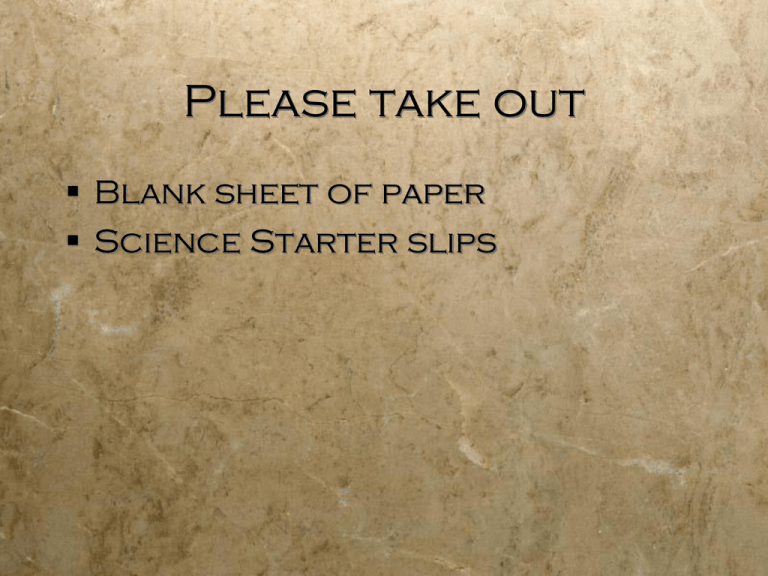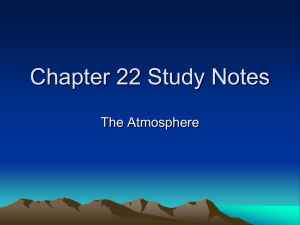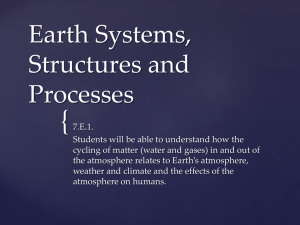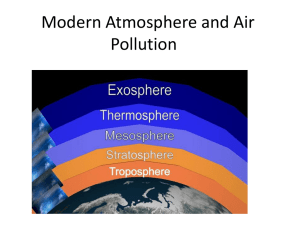Earth`s Changing Atmosphere
advertisement

Please take out Blank sheet of paper Science Starter slips Science Starter If you could drive you car straight up (60 mph) into the sky how long would it take you to reach space? Earth’s Changing Atmosphere Mind Sprint Please take out a sheet of paper. Explain what you already know. The atmosphere is… The atmosphere is made up of… The atmosphere has… The atmosphere is affected by… What we already know At the End of This Unit Some things you will know are… What the atmosphere is and why it is so important for life on Earth. What the atmosphere is made of. How natural cycles affect the atmosphere. How human pollution has affected the atmosphere. When finished with the Pretest Put your scantron and test sheet on the front table. Return to you seat and begin working on your vocab (small Earth’s Atmosphere booklet) Take Out Science Starter slips Agenda Coversheet Packets Earth’s atmosphere booklets Important Dates Parent Signatures- Thurs 2/18 Booklet Check-in #1- Fri 2/19 Booklet Check-in #2- Tues 3/2 Unit Quiz- Tues 3/2 App. Project Quiz- Fri 2/26 App. Project Teaching- Mon 3/1 Science Starter If you are flying in an airplane and your cabin loses pressure, why do oxygen masks drop down? First 20 Minutes Quiet independent work time Earth’s atmosphere booklets Not optional Absorption Atmosphere Carbon cycle Convection Equilibrium Greenhouse effect Greenhouse gas Mesosphere Ozone Stratosphere Troposphere Water cycle Air pollution Altitude Conduction Density Fossil fuel Radiation Smog Thermosphere Ultraviolet radiation Water vapor Infrared radiation Nitrogen cycle Particulate Reflection Note Taking Voices Off Eyes focused on board Writing Down Notes Red is Dead Main Idea: Earth’s atmosphere is a blanket of gases that supports & protects life. Smaller ideas: 1.1 Earth’s Atmosphere supports life. 1.2 The sun supplies the atmosphere’s energy. 1.3 Gases in the atmosphere absorb radiation. 1.4 Human activities affect the atmosphere. First 20 Minutes today Quiet Independent work time Pages 1-4 due Fri 2/19 Take out cover sheet packets I will be checking parent signatures Vocab Words Absorption- When light hits a surface and heats that surface. Reflection- When light hits a surface and bounces off. Equilibrium- A normal state 1.1 Earth’s Atmosphere Supports life. Atmosphere: A whole layer of air that Surrounds earth. • Ends at 300 mi. above Earth’s surface • Keeps Earth warm. • Transports Energy. How thick is Earth’s Atmosphere? Earth = Peach Earth’s Atmosphere = Peach Fuzz Characteristics of the Atmosphere: Altitude: Distance above sea level. Air becomes thinner as altitude increases. Density = Mass/volume Atmosphere’s density decreases as you travel upward. Less Gas = Less Dense < (less) Mass/Volume More Gas = Dense > (greater) Mass/Volume Materials in the atmosphere: Recipe for Air: • Nitrogen gas: 78% • Oxygen gas: 21 % • Argon gas • Carbon dioxide • Water vapor varies Exact amounts of gases can change depending on time of day, location, season... Ongoing Processes: Carbon Cycle (p. 13) Ongoing Processes: Nitrogen Cycle (p. 13) Ongoing Processes: Water Cycle (p. 13) Science Starter: Before we start class, please: (1) Pick up your science textbook. (1) Take our your Earth’s Atmosphere Daily Work Packet. Science Starter: (1) What are the 3 methods of energy movement? (2) Moving from the Earth’s surface towards space, name the atmosphere’s layers in order. 1.2 Energy from the sun heats the Atmosphere All the energy around us comes from the sun. Sun’s Energy Absorbed Sun’s Energy Reflected • 50% Absorbed by Earth’s Surface •25% Reflected by Clouds & Atmosphere •20% Absorbed by Clouds & Atmosphere •5% Reflected by Earth’s Surface Clouds Reflect and Absorb Radiation Solar Radiation The Atmosphere Moves Energy from place to place Radiation: Travel of heat energy by waves through space. Conduction: Transfer of heat energy by direct contact. Convection: Transfer of heat energy by the movement of gas or liquid. http://www.think-energy.co.uk/ThinkEnergy/11-14/activities/ Energy Transfer as Heat Diagram: p. 18 Classify the following as examples of either: conduction, convection or radiation. (1) Blacktop in the parking lot is warmed by sun. (2) Air directly above the blacktop gains heat energy from warm blacktop. (3) The bottom of a fry pan becomes hot as it sits on a hot burner. (4) The sand on the beach burns the bottom of your feet. (5) The bubbles of goo rise to the top of your lava lamp. Atmosphere’s temp. layers Diagram (p. 20) Troposphere: “Turning” • Nearest Earth’s surface • Heated by the ground • Temp. as you in elevation • 80% of total mass of Atmosphere Stratosphere: “Spreading out” • Contains ozone molecules • Absorbs radiation energy from the sun • Temp. as you elevation Mesosphere: “Middle” • Very thin air (< .1% of Atmosphere’s mass) • Heated by stratosphere below • Temp. as you elevation Thermosphere: “heat” • Begins at 56 mi. above Earth • Air becomes less & less dense • Absorbs solar radiation • Temp. as you elevation Analysis: (1) Airplanes fly near the top of the troposphere. Is it more important to heat or cool the passenger cabins? Explain. (2) Ideally, earth should lose about the same amount of energy as it absorbs from the sun. Does energy move from Earth’s surface and atmosphere out to space by radiation, convection or conduction? Explain. Science Starter: Before we start class, please: (1) Pick up your science textbook. (1) Take our your Earth’s Atmosphere Daily Work Packet. Science Starter: (1) Name 4 ways gases can affect radiation. (2) What type of radiation is absorbed by ozone? (3) How do green house gases keep earth warm? 1.3 Gases in the atmosphere absorb Radiation Atmosphere can Affect light in 4 ways: • Absorb light • Reflect light • Let light pass through • Give off light Electromagnetic Spectrum The Ozone Layer protect life from Harmful Radiation • In stratosphere • Absorbs harmful radiation (Uv) from sun Diagram (p. 23) Science Starter: For the first ~25 min. of class you will quiet, individual work time to work on the following: • Finish (& hand in) absorption & radiation lab • Vocab. organizer • Atmosphere (ch 1) readings & daily work packet By the end of today you should be able to explain: 1. What is the greenhouse effect? 2. What are greenhouse gases (including examples)? 3. What could happen if humans increase the amount of greenhouse gases in earth’s atmosphere? What is the Greenhouse Effect? Keeps Earth warm. Gases in earth’s atmosphere that slow movement of Heat energy away from earth’s surface (jacket) Diagram (p. 25) What are Greenhouse gases? Analysis: (1) What would happen to earth’s temperature if the amount of greenhouse gases in the atmosphere changed?









